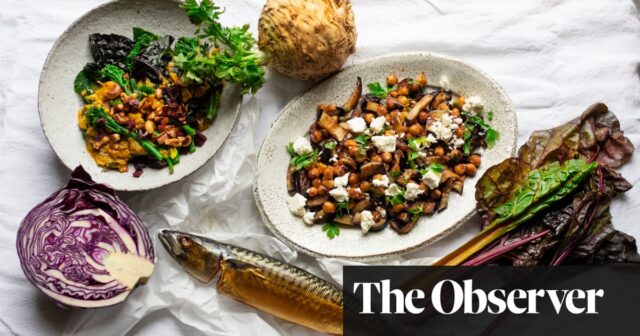Potatoes, dressed warm from the pan, tossed with smoked fish and capers. Rainbow-stemmed chard with a sauce of coconut and spices. Crisp winter roots and hot sausages in a dressing of mustard and cream. Cabbage and fennel with apples and blue cheese, or fried aubergines tossed with rose harissa and feta. These are a few of the salads that are best suited to putting on the table when the weather is cold.
I am not pedantic about whether a salad’s ingredients or its dressing are warm or cold. To me, the best are a thoughtful mixture of raw and cooked, warm and cold, and soft and crisp. What I do like is for a winter salad to have a certain crunch – that texture can come from fennel, frisee or apple, raw white or red cabbage, toasted nuts and croutons, or from potatoes that have been fried till crisp.
A winter salad is all the better for featuring a hot element: snippets of pancetta straight from the frying pan; almonds, cashews or walnuts toasted till they scent the whole kitchen; a coconut milk and tomato dressing made like a curry sauce, or a scattering of chickpeas that have been tossed with harissa or chilli sauce. The contrast of ice-cold crunchy vegetables with searingly hot seasonings can be deeply pleasing.
Croutons are good with the leafier salads. Classically, they are cut into neat squares or slices (croutes) but I much prefer them rough torn. They look better, too. Bake, grill or fry your pieces of jagged bread, toss them in a deep, golden dressing (olive oil, red-wine vinegar, salt, parsley, mustard and perhaps a hint of garlic), then add them to bowls of seasonal leaves, such as white chicory, with thin slices of alpine cheeses – beaufort or comte – and a handful of toasted walnuts.
I would keep most dressings simple so the leaves and vegetables can shine. A little sweetness – honey, date or maple syrup – can balance the bitterness of leaves such as raw brussels sprouts (much milder than when cooked) and feel more suited to the cooler weather. Root vegetables are our friends too: carrots and beetroot can be tossed into salads raw if they are very thinly sliced or roasted, but too many large pieces can render a salad hard going. There are no rules, but one point I do think worth considering is not throwing too many ingredients in your salad, and especially into the dressing. Even in winter, simple is usually the best way to go.
Celeriac and sausage remoulade
Crunchy root vegetables, sizzling sausages and a simple mustard, cream and parsley dressing.
Serves 3
butcher’s sausages 6 plump, slightly garlicky
olive oil
celeriac about 500g
lemon juice 1 tbsp, plus an extra squeeze
groundnut oil 3 tbsp
walnut oil 1 tbsp
dijon mustard 2 tsp
parsley leaves 25g
double cream 3 tbsp
Put the sausages, with a little olive oil, into a shallow pan and let them cook over a moderate heat till deep golden brown, turning them now and again so they colour evenly.
Peel the celeriac. Squeeze a little lemon juice into the bowl of a food processor fitted with a coarse grater setting (or use the coarse side of a box grater), then grate the celeriac and tip into a deep mixing bowl.
Mix the groundnut and walnut oil, the tablespoon of lemon juice and the dijon mustard, whisking with a fork or small whisk, or shaking it up in a jam jar. Finely chop the parsley leaves and add them to the dressing with the double cream, then pour over the celeriac and toss well to mix.
Remove the sausages from the pan and let them rest for a few minutes (if you cut them immediately, all their juices will escape), then slice each one into five or six pieces. Toss them with the salad. If you wish, include any fat from the sausage pan, then serve in a deep bowl or platter.
Red cabbage, blue cheese, maple syrup
The crispest of winter vegetables and fruit – red cabbage, fennel and cox’s apples – dressed with the warm notes of maple syrup and red-wine vinegar. A salad with which to bring out the blue cheeses such Harborne, Cashel or Beenleigh. Their piquancy marries well with a slightly sweet dressing.
Serves 3-4
red cabbage 350g
fennel 1 small bulb
apple 1, crisp, possibly cox’s
blue cheese 150g, such as Harborne, Cashel or Beenleigh
walnut halves a handful
For the dressing
red-wine vinegar 2 tbsp
dijon mustard 2 tsp
groundnut oil 3 tbsp
olive oil 2 tbsp
maple syrup 2 tbsp
Make the dressing first: pour the vinegar into small bowl. Add the mustard, groundnut oil, olive oil, maple syrup and a generous seasoning of salt and pepper. Mix well with a small whisk or fork.
Finely shred the red cabbage and soak it in a bowl of iced water. Shred the fennel and add to the cabbage. This brief steeping in ice and water will crisp it up. Halve and core the apple, then slice thinly and drop into the dressing.
Drain the cabbage and fennel and toss with the dressing. Transfer to a serving dish, then add the cheese in large pieces and the walnuts to the salad.
Aubergine, feta, chickpeas and rose harissa
Fingers of aubergine, fried, with a dressing made substantial thanks to the warmth of the chilli paste and the sour-salty notes of the feta.
Serves 4
aubergines 650g
groundnut oil 180ml
garlic 2 plump cloves
harissa paste 2 heaped tbsp
chickpeas 400g, bottled or tinned
parsley 10g
feta 150g
Remove and discard the green stem from the aubergines, then cut each fruit lengthways into thick slices – roughly 5mm in width – then cut each slice across to give short “chips”.
Warm the oil in a shallow-sided pan, drop in the whole garlic cloves to scent the oil, then add about a third of the aubergine chips and fry for 5 or so minutes, turning each one with kitchen tongs. Continue cooking until they turn golden on each side. Remove to kitchen paper, then repeat with the other pieces of aubergine. Salt lightly.
Return the empty pan to the heat and stir the harissa paste into any residual olive oil. Cook for a minute, then tip in the chickpeas. Stir them through the harissa and leave until warm. Remove the parsley leaves from their stems. Crumble the feta cheese and mix with the parsley.
Put the aubergine chips on to a serving plate, and scatter over the harissa chickpeas, crumbled feta and parsley.
Broccoli with coconut milk and cashews
A salad of warm winter greens and spiced coconut sauce. The chard is cooked in two parts; the leaves are plunged into boiling, salted water, while the stems are chopped and fried with toasted cashews.
Serves 2
groundnut or vegetable oil 2 tbsp
onion 1 medium, finely chopped
cardamom pods 6
cumin seeds 1 tsp
coriander seeds 2 tsp
garlic 3 plump cloves, peeled and crushed
ginger 60g, peeled and finely grated
red chillies 2 small, chopped
turmeric 2 tsp
tomatoes 3 medium, chopped
curry leaves 20
coconut cream 125ml
long-stemmed broccoli 150g
rainbow chard 150g
cashews 50g
Warm the oil in a deep saucepan. Stir in the chopped onion and cook over a moderate heat till soft and pale gold.
Remove the seeds from the cardamom and put them in a mortar or spice grinder. Add the cumin and coriander seeds, then grind to a fine powder. Stir into the onions.
Stir the garlic into the onions, then add the ginger. Continue cooking, stirring regularly, then add the chillies together with the turmeric. Stir in the chopped tomatoes and the whole curry leaves.
When the tomatoes have collapsed, pour in 400ml of water and bring to the boil, then lower the heat and let the mixture simmer gently for about 20 minutes. Stir in the coconut cream.
Bring a large pan of lightly salted water to the boil. Strip the leaves from the chard and trim the ends from the stalks of the broccoli. Cut the chard stalks into small pieces. When the water comes to the boil, dunk in the broccoli and the chard leaves and leave them for 2 minutes till the colours are bright. Drain and set aside.
In a shallow pan, fry the cashews in a little oil until they are pale gold. Stir in the chopped chard stalks and cook for a minute or two till soft and bright. Add the chard and broccoli to the sauce, then transfer to a serving dish, scattering the cashews and chard stalks over as you go.
Mackerel, potato, mustard
A simple fish and potato supper, the smoked mackerel broken into jagged pieces and tossed with hot, crisp-edged sauteed potatoes and dressed with a mustard and caper vinaigrette. Should you wish to add some leaves, I suggest curls of frisee or young spinach. Although you could serve this cold, I like the contrast between the cool, soft fish and crisp, hot potatoes.
Serves 4
waxy potatoes 750g, smallish
olive oil 3 tbsp
smoked mackerel 1 whole fish or 2 large fillets
For the dressing
dijon mustard 1 tbsp
grain mustard 1 tbsp
red-wine vinegar 2 tbsp
capers 2 tsp
olive oil 3 tbsp
parsley leaves a good handful
Scrub then steam the potatoes in a steamer or colander placed over a deep pan of boiling water. When they are tender to the point of a metal skewer, remove from the heat and slice in half lengthwise.
While the potatoes are steaming, make the dressing: put the mustards in a small bowl, stir or whisk in the vinegar, a little salt and black pepper, then add the capers and whisk in the olive oil. Chop the parsley leaves and stir into the dressing.
Warm the other 3 tablespoons of the olive oil in a shallow pan over a moderate heat, then add the potatoes, cut-side down. Let them cook for 6-8 minutes until they are golden and crisp, then remove.
Remove the mackerel from its skin. Break into juicy pieces, then toss them lightly with the potatoes and some of the dressing. Divide between four plates, then spoon over any extra dressing.






